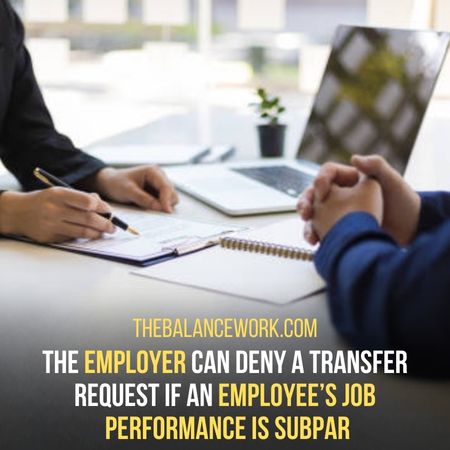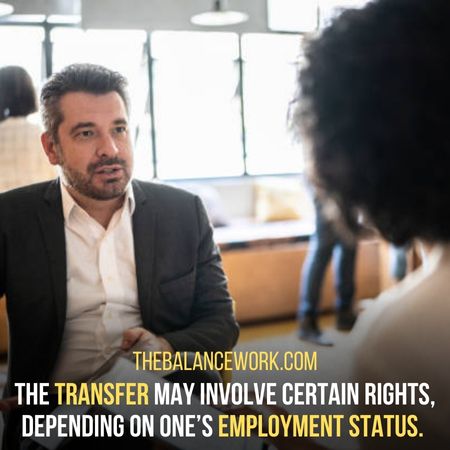Can an employer stop you from transferring? Transferring to another position within the same company is generally allowed.
Most employers also encourage it. It can help maintain employee satisfaction and morale.
When Can An Employer Stop You From Transferring
Yes, an employer can stop you from transferring. Employers have the right to deny your transfer request. An employer could use factors like performance and seniority to deny a transfer.
Financial constraints may also prevent a company from an employee transfer.
Let’s discuss circumstances in which an employer may prevent or restrict a transfer.
1. Job Performance:
The employer can deny a transfer request if an employee’s job performance is subpar. In this instance, employers expect an employee to improve performance before transferring.

Employers want to transfer employees with a proven track record of quality work.
No company wants to transfer a poor performer to another department or location. The employer can deny a transfer request if an employee performs below standards.
Employers may need an employee’s improved job performance before accepting a transfer request..
And if the employee is not meeting the requirements, the transfer request may get denied.
2. Seniority:
Seniority is often used to determine who gets priority regarding transfers. Senior employees get the first opportunity for new transfers and promotions mostly.
More experienced employees may get allowed or placed on a waiting list. This is often done to ensure that those with the most experience and knowledge have priority.
Also, the company may already have several employees with seniority in the department.
The employer may refuse to transfer a less experienced employee into that department.
A transfer may get denied due to seniority. The employer may need to give evidence that there were no other qualified candidates.
3. Company Needs:
An employer can deny an employee’s transfer request if it does not fit the company’s needs. Companies are subject to changing demands, and they must adjust accordingly.
For example, the company needs to reduce costs by cutting back on labor expenses. A transfer could get refused.
Likewise, a crucial project requires workers with particular skills. Then the company may only accept a request to transfer someone with that skill set.
Some companies may also deny a transfer request on the company’s needs. They may have to fill positions in other departments deemed more important.
4. Contractual Obligations:
Employees who work under a contractual agreement may find their transfer requests denied. The contract may explicitly prohibit it.
These agreements may also have clauses. For instance, it may limit the geographic area where the employee may transfer.
Furthermore, this could be a condition of employment. It could also be a refusal to accept such limitations that could result in dismissal.
Some agreements have clauses that make a notice period for a transfer request to be valid.
The employer may have the right to decline a request if it is not made within the stipulated period.
5. Company Policy:
A company may also implement certain policies related to transfers and promotions. An employer might have a policy prohibiting transfers within the same department.

The company may notify certain employees when transfers become available. They may be restricting transfers to certain locations or departments.
The company may require employees to get prior approval before transferring.
Ultimately, employers should inform their employees of any restrictions or policies on transferring.
They must make sure that these policies get enforced uniformly across the organization.
6. Costs:
Employers may also only allow employees to transfer if it is affordable. Suppose the company must cover relocation costs or training for a new position.
They may decide it is not in their best financial interest to allow an employee to transfer.
Additionally, transferring employees can disrupt existing teams. They need time and resources to adjust and get up-to-speed with the new teammate.
This could also lead to increased costs for the employer. Employers need to consider the costs before allowing or preventing an employee from transferring.
7. Interfering With Opportunities:
Companies need to be careful not to interfere with potential opportunities for employees.
Suppose an employer actively prevents an employee from transferring. Or they refuse to provide a reference that could help the employee get a new job.
In that case, this is considered to interfere with the employee’s opportunities. It is illegal for employers to interfere in this way.
And they can face legal repercussions if found guilty of such behavior. Employers may be liable for damages by the employee due to their interference.
Employers should always strive to create an environment. Employees should feel supported and encouraged when looking for new career opportunities.
8. Political Reasons:
Employers may stop an employee from transferring for political reasons. They may worry a transfer could affect their reputation or relationships with workers.
There could be legal ramifications if the employee transfers to a rival company.
Employers must consider the implications of allowing an employee to transfer.
Regardless of why employers decide not to allow employees to transfer, they must do so legally and fairly.
Employees should have the right to pursue opportunities elsewhere if desired. There should be no fear of retribution or injustice.
Roles Of Human Resource Management In Employee Transfer
Transfer is an important part of human resource management. And there are several roles it plays in the process.

Here are some roles that HR plays in employee transfers:
1. Ensure Transparency:
Human resource management must ensure that the transfer process is transparent and fair.
All employees must be made aware of transfer policies and procedures in advance.
This will allow them to make an informed decision about whether or not to transfer.
Some organizations may need employees to sign a transfer agreement.
2. Ensure Legal Compliance:
Human resource management must ensure that all transfers follow applicable laws and regulations.
For example, an employee is transferred to a different state or country. They may need to obtain a work visa.
Organizations must also follow local and state laws about the transfer of employees.
3. Consider Transferring Costs:
Organizations need to consider the cost of transferring an employee. These may include relocation costs and travel expenses.
They must also consider the cost of training employees in their new position. They must provide them with any necessary tools or equipment.
They should consider the impact on morale by allowing certain employees to transfer. This can be a source of tension between workers and management.
4. Employee’s Right To Refuse Transfer:
Ultimately, an employee has the right to refuse a transfer. An employer cannot force them to move to a new location, but they can make it difficult for them to stay.
For example, an employer may offer a lower salary or fewer benefits for the new position. They may also reduce job security to encourage the employee to transfer.
It is important to remember that an employee has the right to refuse a transfer. An employer should always respect this decision and provide other options.
Some employers may choose to terminate an employee who refuses a transfer. This is illegal. And the employee can file a complaint with the appropriate labor commission or court.
Rights To Consider Before Transferring
The transfer may involve certain rights, depending on one’s employment status. Let’s look at these rights and how they apply when an employer asks an employee to transfer.
1. Unionized Employees:
Unionized employees should always negotiate with their union before accepting any transfer. A collective agreement or contract may give the employee certain rights and protections.

So it is important to review and understand the agreement before making any decisions.
A unionized employee should always check with the union representative. After that they should be accepting or refusing any transfer.
2. Non-Union Employees:
Non-union employees may not have the same protection as their unionized counterparts. But there are still some rights to consider before transferring.
For example, the transfer is within the same company and involves a promotion. The employee may have the right to negotiate for better pay and benefits.
Furthermore, the involuntary transfer will result in a significant decrease in salary or benefits. Then, the employee may have legal grounds to challenge the transfer.
The employee should consult a lawyer to review the applicable laws and regulations. They should check if certain restrictions are in place due to a current job contract.
Final Word:
So can an employer stop you from transferring? In some cases, yes. An employer may have a legal right to restrict employee transfers in certain circumstances.
Employees must know their rights. They should consult a lawyer if they feel their transfer is unfairly restricted.
Doing so can help protect their rights and ensure they are treated fairly in the workplace.
Employees should keep an open dialogue with their employer. This can ensure that any transfer restrictions are clear, fair, and legally sound.
Last Updated on 10 hours by Aleena
- Why Does My Boss Wink At Me? 6 Potential Reasons - October 5, 2023
- Is It Legal For Your Employer To Call Your Doctor? No, But… - October 4, 2023
- 12 Ways To Deal With A Low IQ Person - September 22, 2023